BUSN20016 Research: Australian Real Estate During Economic Downturns
VerifiedAdded on 2023/03/30
|26
|4201
|150
Report
AI Summary
This report provides a comparative analysis of the Australian real estate market during various economic downturns, focusing on the impact of booms, recessions, and busts. It examines the role of the real estate market in the Australian GDP, identifies the causes of financial crises, and assesses the impact on financial institutions. The study uses a conceptual framework that includes economic downturns, construction cycles, and Australian context, considering factors like inflation and interest rates. The research methodology involves secondary data analysis to understand the effects of economic fluctuations on the real estate sector, offering valuable insights for real estate contractors, economists, and tenants. Desklib offers a platform to explore this document along with other solved assignments and past papers.
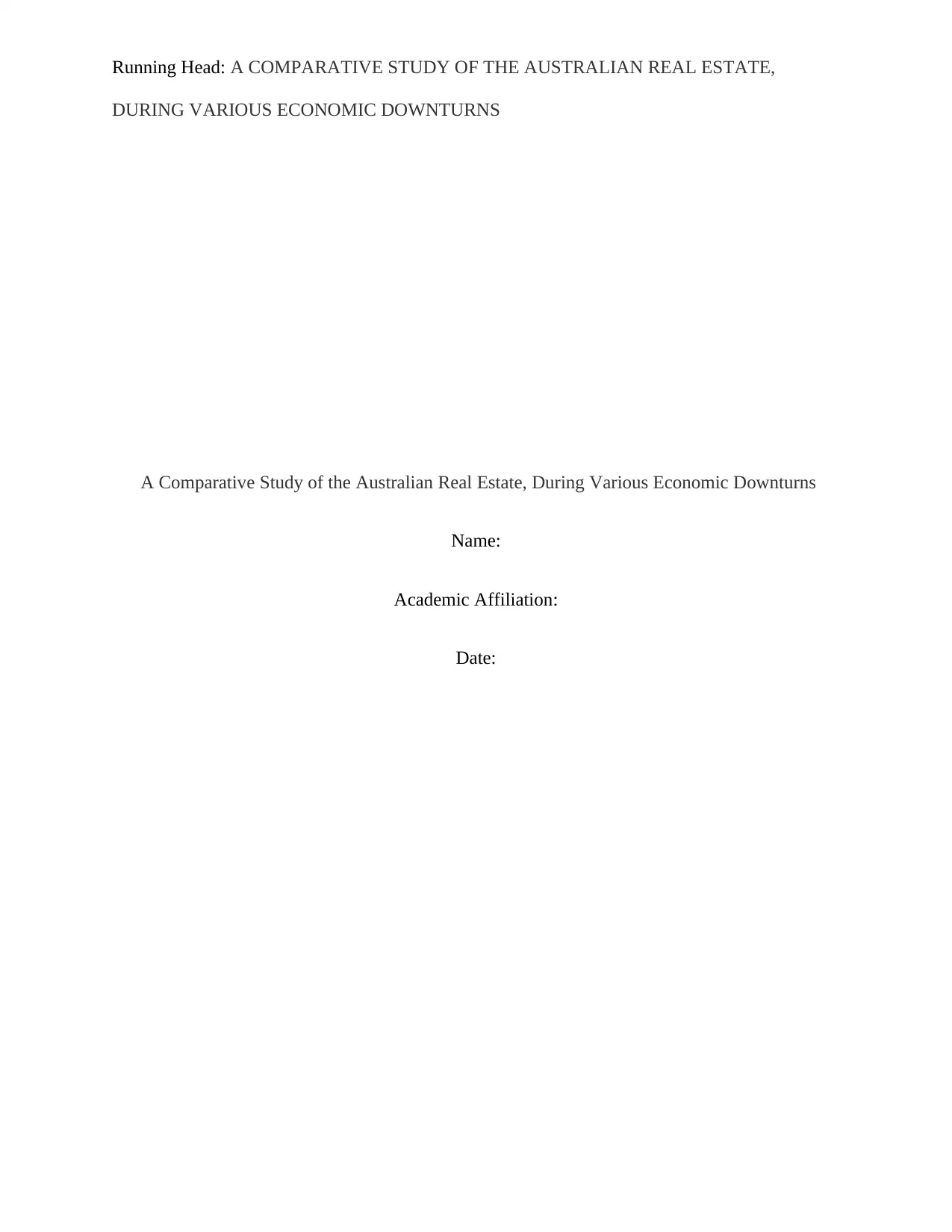
Running Head: A COMPARATIVE STUDY OF THE AUSTRALIAN REAL ESTATE,
DURING VARIOUS ECONOMIC DOWNTURNS
A Comparative Study of the Australian Real Estate, During Various Economic Downturns
Name:
Academic Affiliation:
Date:
DURING VARIOUS ECONOMIC DOWNTURNS
A Comparative Study of the Australian Real Estate, During Various Economic Downturns
Name:
Academic Affiliation:
Date:
Paraphrase This Document
Need a fresh take? Get an instant paraphrase of this document with our AI Paraphraser
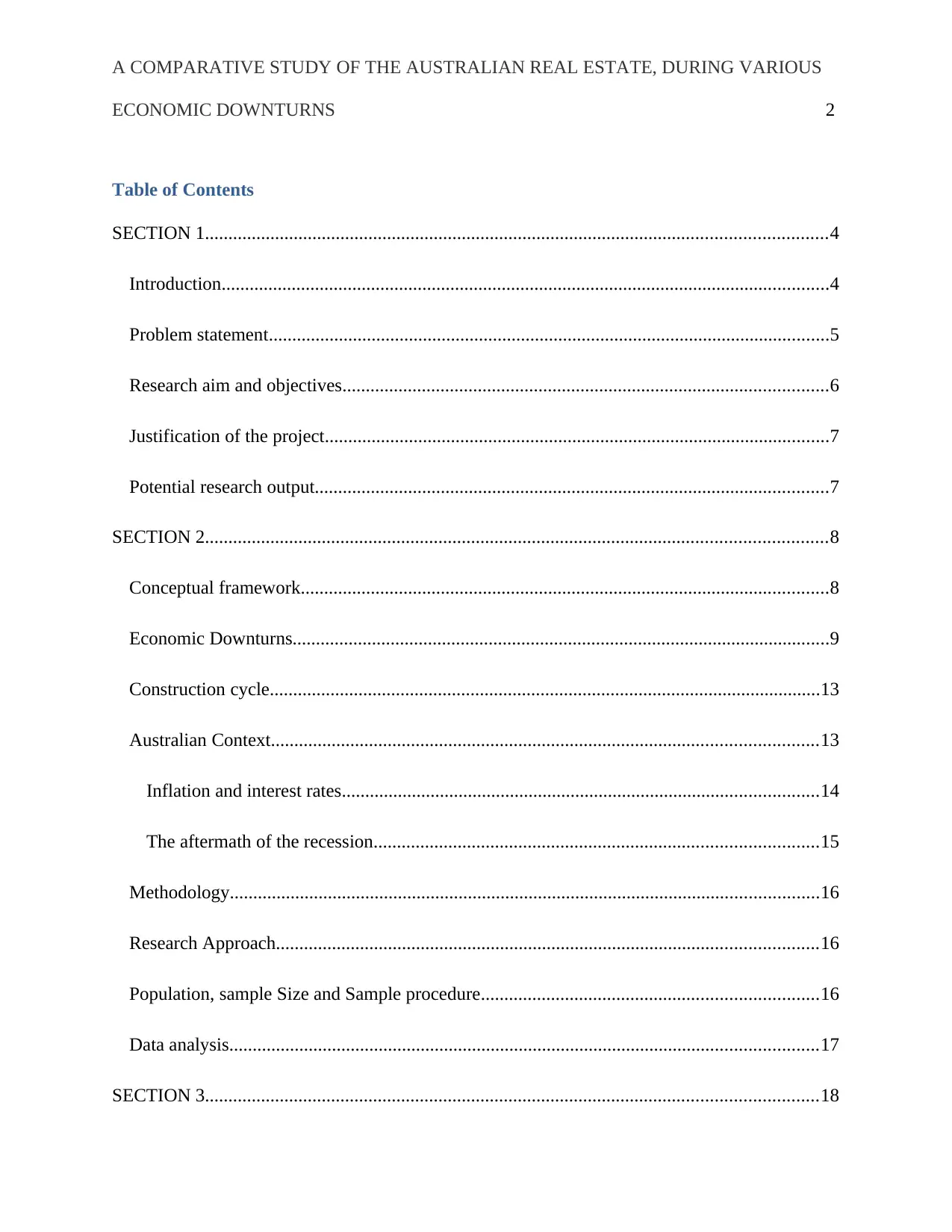
A COMPARATIVE STUDY OF THE AUSTRALIAN REAL ESTATE, DURING VARIOUS
ECONOMIC DOWNTURNS 2
Table of Contents
SECTION 1.....................................................................................................................................4
Introduction..................................................................................................................................4
Problem statement........................................................................................................................5
Research aim and objectives........................................................................................................6
Justification of the project............................................................................................................7
Potential research output..............................................................................................................7
SECTION 2.....................................................................................................................................8
Conceptual framework.................................................................................................................8
Economic Downturns...................................................................................................................9
Construction cycle......................................................................................................................13
Australian Context.....................................................................................................................13
Inflation and interest rates......................................................................................................14
The aftermath of the recession...............................................................................................15
Methodology..............................................................................................................................16
Research Approach....................................................................................................................16
Population, sample Size and Sample procedure........................................................................16
Data analysis..............................................................................................................................17
SECTION 3...................................................................................................................................18
ECONOMIC DOWNTURNS 2
Table of Contents
SECTION 1.....................................................................................................................................4
Introduction..................................................................................................................................4
Problem statement........................................................................................................................5
Research aim and objectives........................................................................................................6
Justification of the project............................................................................................................7
Potential research output..............................................................................................................7
SECTION 2.....................................................................................................................................8
Conceptual framework.................................................................................................................8
Economic Downturns...................................................................................................................9
Construction cycle......................................................................................................................13
Australian Context.....................................................................................................................13
Inflation and interest rates......................................................................................................14
The aftermath of the recession...............................................................................................15
Methodology..............................................................................................................................16
Research Approach....................................................................................................................16
Population, sample Size and Sample procedure........................................................................16
Data analysis..............................................................................................................................17
SECTION 3...................................................................................................................................18
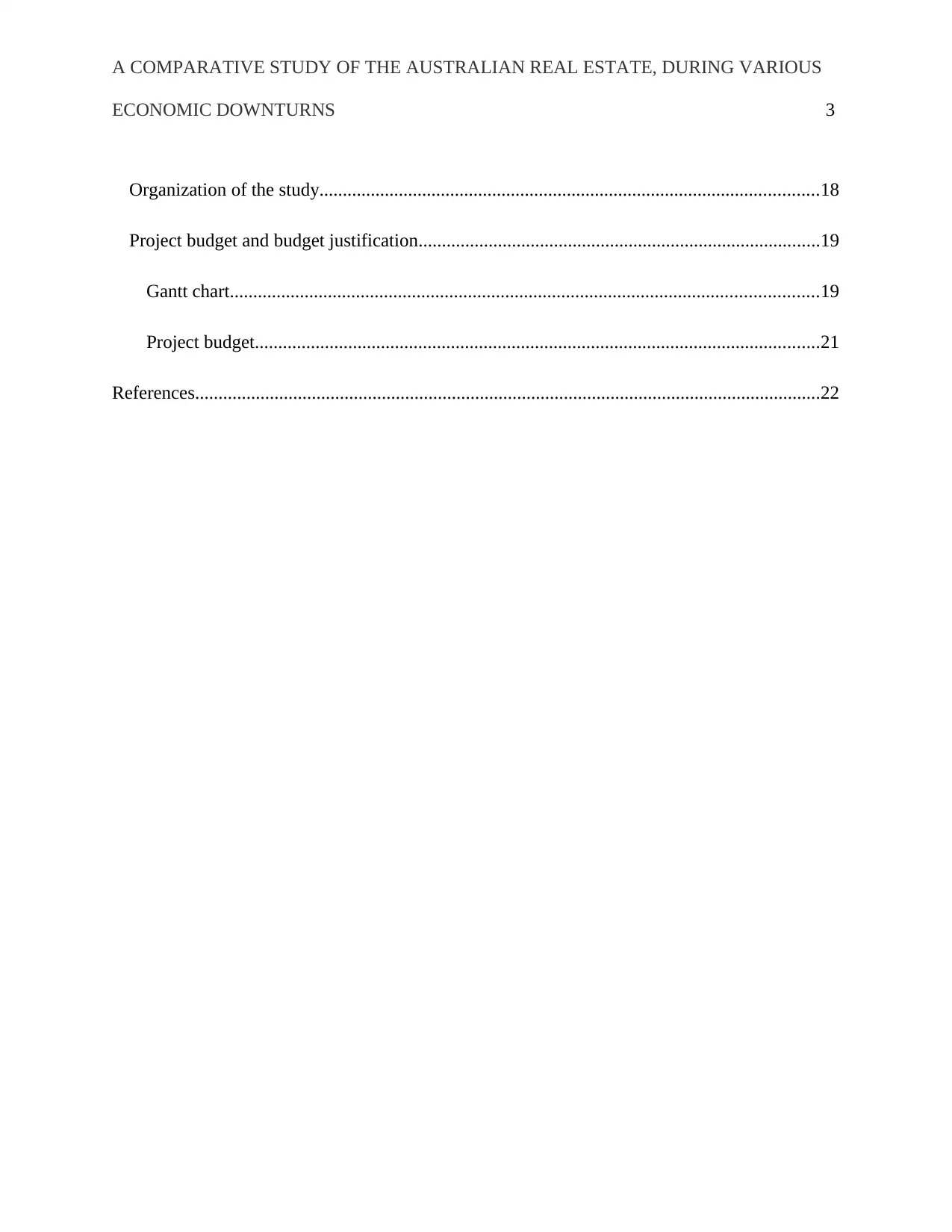
A COMPARATIVE STUDY OF THE AUSTRALIAN REAL ESTATE, DURING VARIOUS
ECONOMIC DOWNTURNS 3
Organization of the study...........................................................................................................18
Project budget and budget justification......................................................................................19
Gantt chart..............................................................................................................................19
Project budget.........................................................................................................................21
References......................................................................................................................................22
ECONOMIC DOWNTURNS 3
Organization of the study...........................................................................................................18
Project budget and budget justification......................................................................................19
Gantt chart..............................................................................................................................19
Project budget.........................................................................................................................21
References......................................................................................................................................22
⊘ This is a preview!⊘
Do you want full access?
Subscribe today to unlock all pages.

Trusted by 1+ million students worldwide
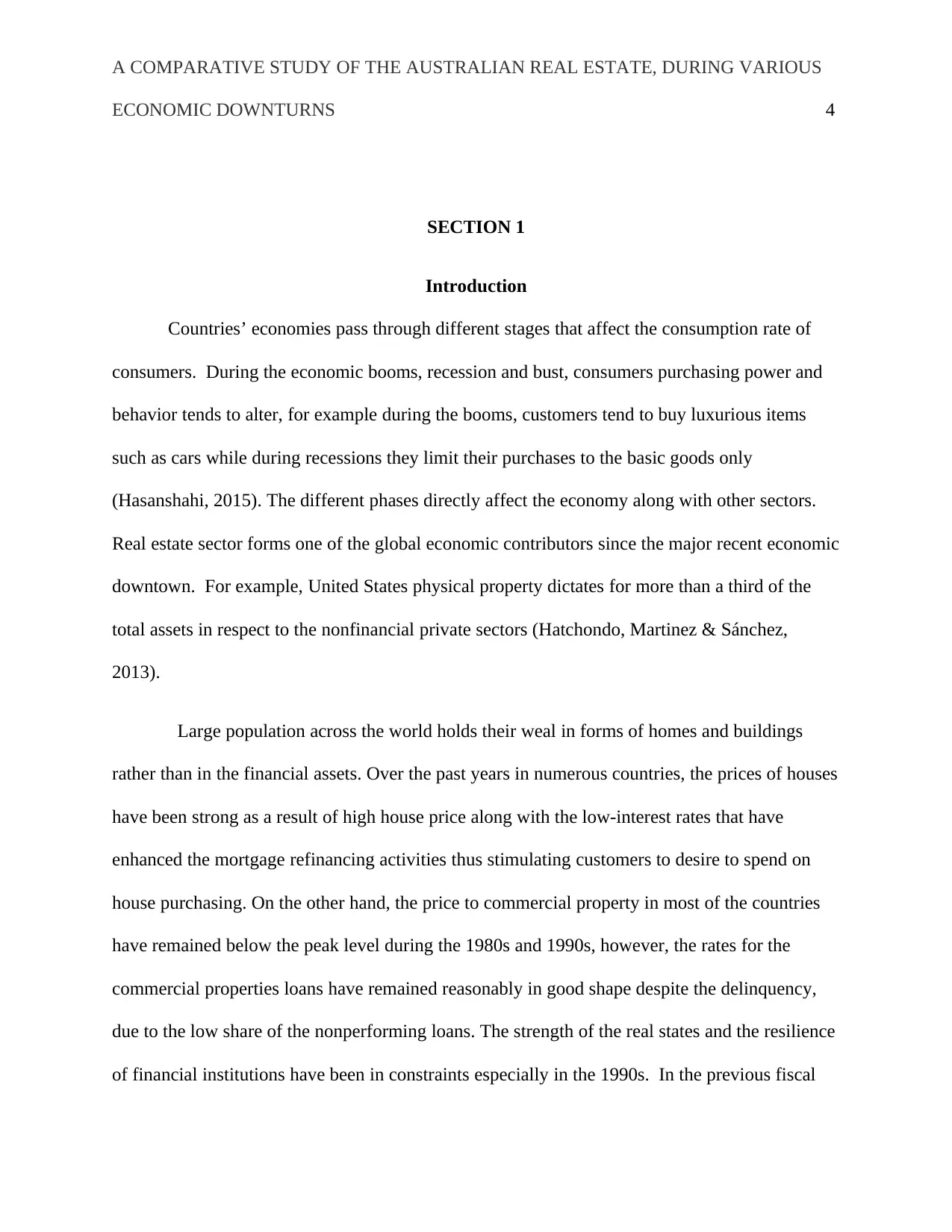
A COMPARATIVE STUDY OF THE AUSTRALIAN REAL ESTATE, DURING VARIOUS
ECONOMIC DOWNTURNS 4
SECTION 1
Introduction
Countries’ economies pass through different stages that affect the consumption rate of
consumers. During the economic booms, recession and bust, consumers purchasing power and
behavior tends to alter, for example during the booms, customers tend to buy luxurious items
such as cars while during recessions they limit their purchases to the basic goods only
(Hasanshahi, 2015). The different phases directly affect the economy along with other sectors.
Real estate sector forms one of the global economic contributors since the major recent economic
downtown. For example, United States physical property dictates for more than a third of the
total assets in respect to the nonfinancial private sectors (Hatchondo, Martinez & Sánchez,
2013).
Large population across the world holds their weal in forms of homes and buildings
rather than in the financial assets. Over the past years in numerous countries, the prices of houses
have been strong as a result of high house price along with the low-interest rates that have
enhanced the mortgage refinancing activities thus stimulating customers to desire to spend on
house purchasing. On the other hand, the price to commercial property in most of the countries
have remained below the peak level during the 1980s and 1990s, however, the rates for the
commercial properties loans have remained reasonably in good shape despite the delinquency,
due to the low share of the nonperforming loans. The strength of the real states and the resilience
of financial institutions have been in constraints especially in the 1990s. In the previous fiscal
ECONOMIC DOWNTURNS 4
SECTION 1
Introduction
Countries’ economies pass through different stages that affect the consumption rate of
consumers. During the economic booms, recession and bust, consumers purchasing power and
behavior tends to alter, for example during the booms, customers tend to buy luxurious items
such as cars while during recessions they limit their purchases to the basic goods only
(Hasanshahi, 2015). The different phases directly affect the economy along with other sectors.
Real estate sector forms one of the global economic contributors since the major recent economic
downtown. For example, United States physical property dictates for more than a third of the
total assets in respect to the nonfinancial private sectors (Hatchondo, Martinez & Sánchez,
2013).
Large population across the world holds their weal in forms of homes and buildings
rather than in the financial assets. Over the past years in numerous countries, the prices of houses
have been strong as a result of high house price along with the low-interest rates that have
enhanced the mortgage refinancing activities thus stimulating customers to desire to spend on
house purchasing. On the other hand, the price to commercial property in most of the countries
have remained below the peak level during the 1980s and 1990s, however, the rates for the
commercial properties loans have remained reasonably in good shape despite the delinquency,
due to the low share of the nonperforming loans. The strength of the real states and the resilience
of financial institutions have been in constraints especially in the 1990s. In the previous fiscal
Paraphrase This Document
Need a fresh take? Get an instant paraphrase of this document with our AI Paraphraser
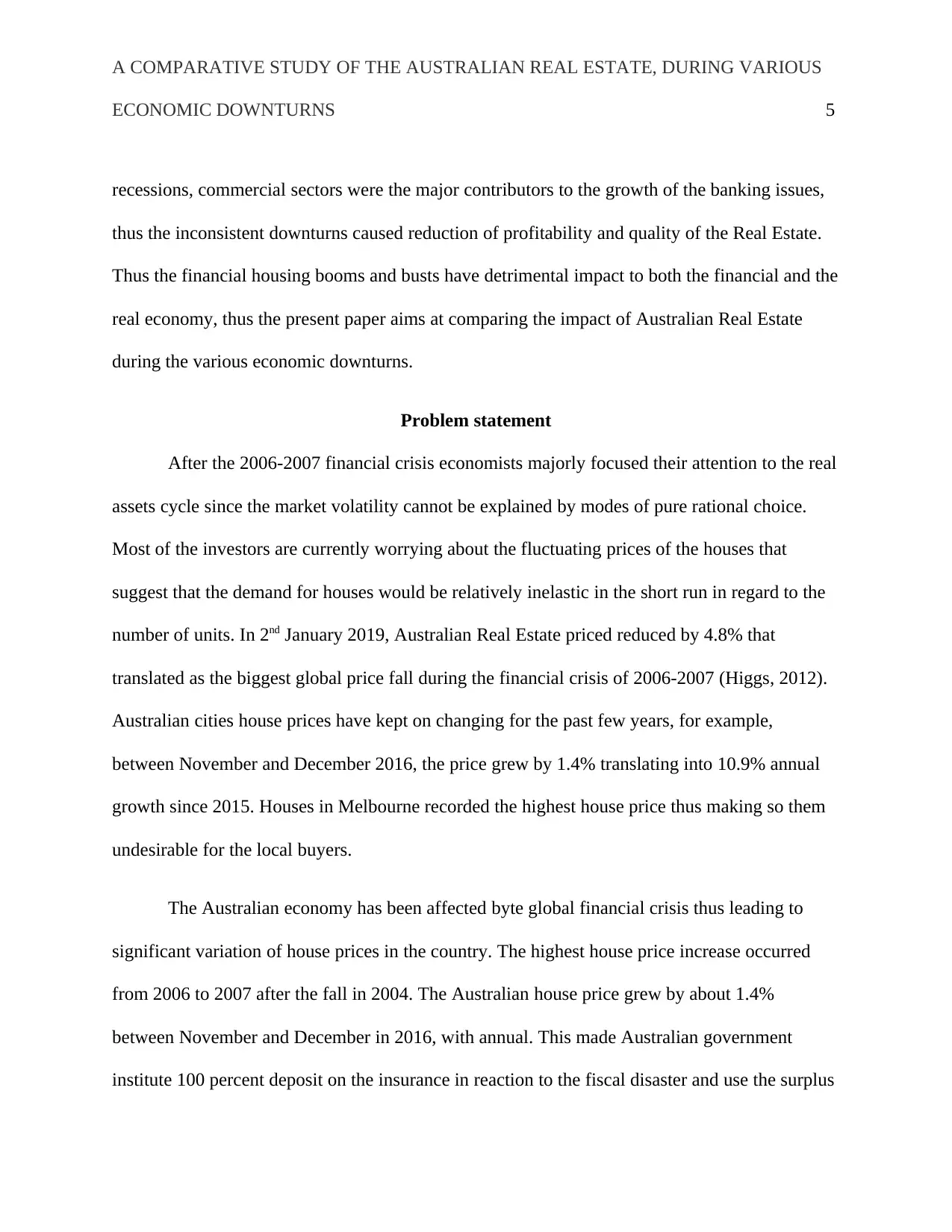
A COMPARATIVE STUDY OF THE AUSTRALIAN REAL ESTATE, DURING VARIOUS
ECONOMIC DOWNTURNS 5
recessions, commercial sectors were the major contributors to the growth of the banking issues,
thus the inconsistent downturns caused reduction of profitability and quality of the Real Estate.
Thus the financial housing booms and busts have detrimental impact to both the financial and the
real economy, thus the present paper aims at comparing the impact of Australian Real Estate
during the various economic downturns.
Problem statement
After the 2006-2007 financial crisis economists majorly focused their attention to the real
assets cycle since the market volatility cannot be explained by modes of pure rational choice.
Most of the investors are currently worrying about the fluctuating prices of the houses that
suggest that the demand for houses would be relatively inelastic in the short run in regard to the
number of units. In 2nd January 2019, Australian Real Estate priced reduced by 4.8% that
translated as the biggest global price fall during the financial crisis of 2006-2007 (Higgs, 2012).
Australian cities house prices have kept on changing for the past few years, for example,
between November and December 2016, the price grew by 1.4% translating into 10.9% annual
growth since 2015. Houses in Melbourne recorded the highest house price thus making so them
undesirable for the local buyers.
The Australian economy has been affected byte global financial crisis thus leading to
significant variation of house prices in the country. The highest house price increase occurred
from 2006 to 2007 after the fall in 2004. The Australian house price grew by about 1.4%
between November and December in 2016, with annual. This made Australian government
institute 100 percent deposit on the insurance in reaction to the fiscal disaster and use the surplus
ECONOMIC DOWNTURNS 5
recessions, commercial sectors were the major contributors to the growth of the banking issues,
thus the inconsistent downturns caused reduction of profitability and quality of the Real Estate.
Thus the financial housing booms and busts have detrimental impact to both the financial and the
real economy, thus the present paper aims at comparing the impact of Australian Real Estate
during the various economic downturns.
Problem statement
After the 2006-2007 financial crisis economists majorly focused their attention to the real
assets cycle since the market volatility cannot be explained by modes of pure rational choice.
Most of the investors are currently worrying about the fluctuating prices of the houses that
suggest that the demand for houses would be relatively inelastic in the short run in regard to the
number of units. In 2nd January 2019, Australian Real Estate priced reduced by 4.8% that
translated as the biggest global price fall during the financial crisis of 2006-2007 (Higgs, 2012).
Australian cities house prices have kept on changing for the past few years, for example,
between November and December 2016, the price grew by 1.4% translating into 10.9% annual
growth since 2015. Houses in Melbourne recorded the highest house price thus making so them
undesirable for the local buyers.
The Australian economy has been affected byte global financial crisis thus leading to
significant variation of house prices in the country. The highest house price increase occurred
from 2006 to 2007 after the fall in 2004. The Australian house price grew by about 1.4%
between November and December in 2016, with annual. This made Australian government
institute 100 percent deposit on the insurance in reaction to the fiscal disaster and use the surplus
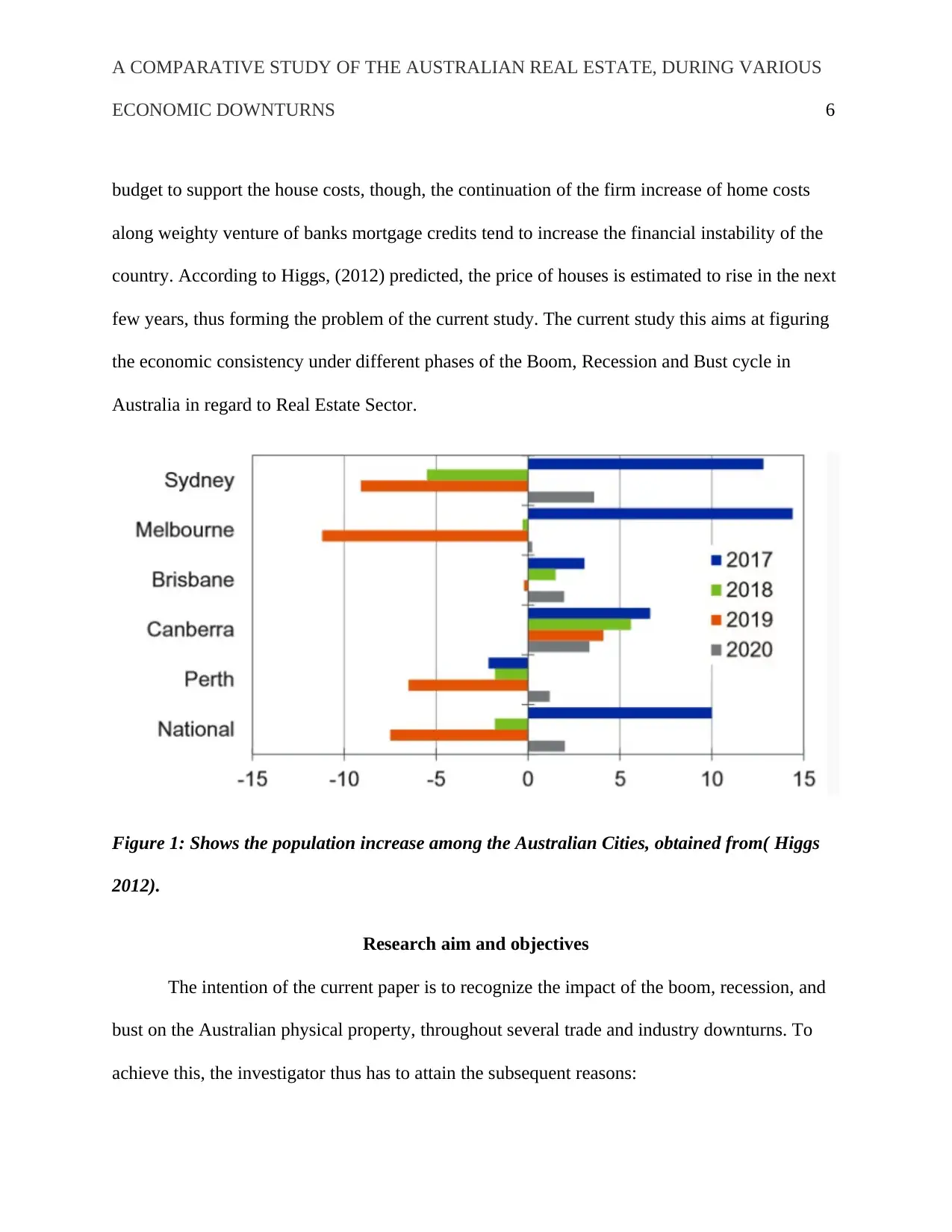
A COMPARATIVE STUDY OF THE AUSTRALIAN REAL ESTATE, DURING VARIOUS
ECONOMIC DOWNTURNS 6
budget to support the house costs, though, the continuation of the firm increase of home costs
along weighty venture of banks mortgage credits tend to increase the financial instability of the
country. According to Higgs, (2012) predicted, the price of houses is estimated to rise in the next
few years, thus forming the problem of the current study. The current study this aims at figuring
the economic consistency under different phases of the Boom, Recession and Bust cycle in
Australia in regard to Real Estate Sector.
Figure 1: Shows the population increase among the Australian Cities, obtained from( Higgs
2012).
Research aim and objectives
The intention of the current paper is to recognize the impact of the boom, recession, and
bust on the Australian physical property, throughout several trade and industry downturns. To
achieve this, the investigator thus has to attain the subsequent reasons:
ECONOMIC DOWNTURNS 6
budget to support the house costs, though, the continuation of the firm increase of home costs
along weighty venture of banks mortgage credits tend to increase the financial instability of the
country. According to Higgs, (2012) predicted, the price of houses is estimated to rise in the next
few years, thus forming the problem of the current study. The current study this aims at figuring
the economic consistency under different phases of the Boom, Recession and Bust cycle in
Australia in regard to Real Estate Sector.
Figure 1: Shows the population increase among the Australian Cities, obtained from( Higgs
2012).
Research aim and objectives
The intention of the current paper is to recognize the impact of the boom, recession, and
bust on the Australian physical property, throughout several trade and industry downturns. To
achieve this, the investigator thus has to attain the subsequent reasons:
⊘ This is a preview!⊘
Do you want full access?
Subscribe today to unlock all pages.

Trusted by 1+ million students worldwide
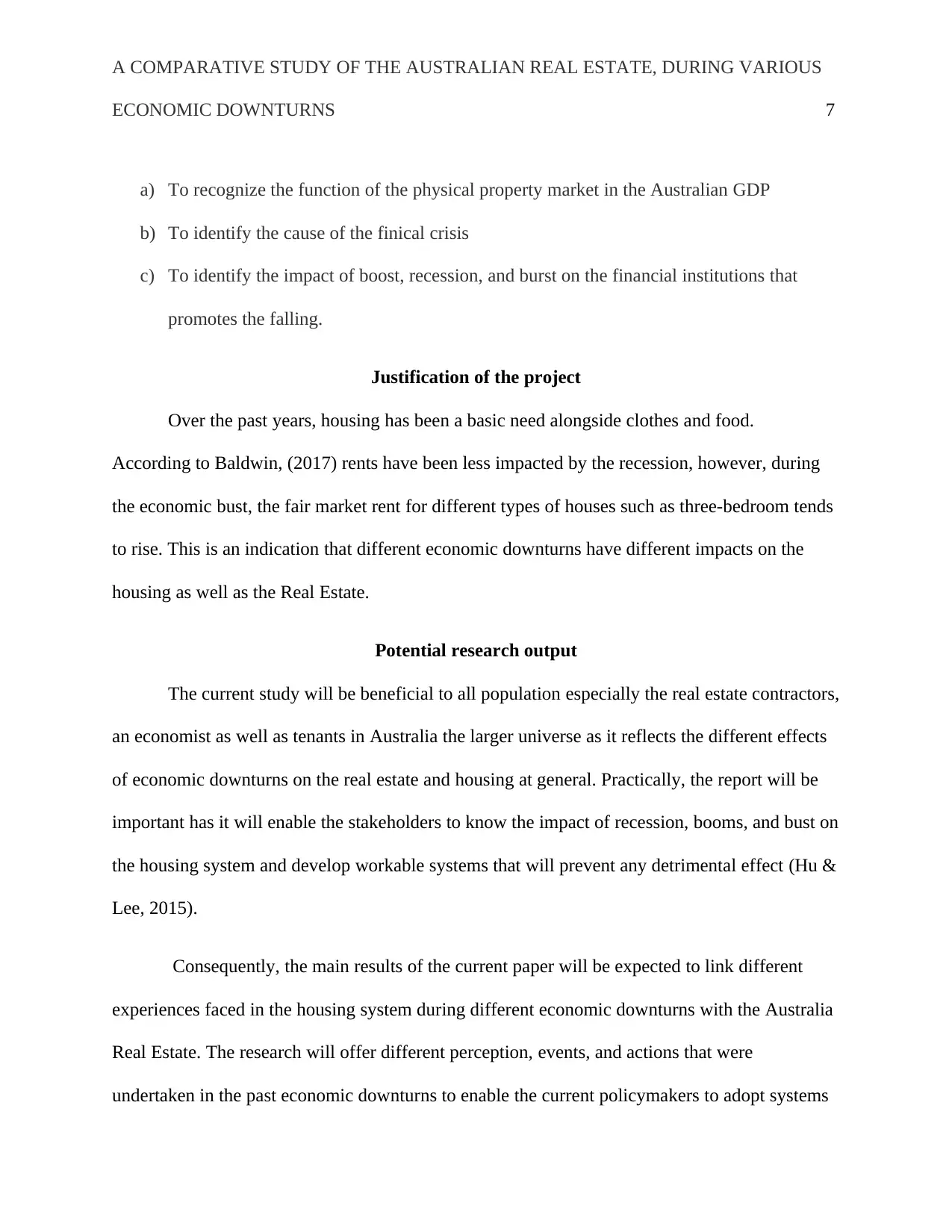
A COMPARATIVE STUDY OF THE AUSTRALIAN REAL ESTATE, DURING VARIOUS
ECONOMIC DOWNTURNS 7
a) To recognize the function of the physical property market in the Australian GDP
b) To identify the cause of the finical crisis
c) To identify the impact of boost, recession, and burst on the financial institutions that
promotes the falling.
Justification of the project
Over the past years, housing has been a basic need alongside clothes and food.
According to Baldwin, (2017) rents have been less impacted by the recession, however, during
the economic bust, the fair market rent for different types of houses such as three-bedroom tends
to rise. This is an indication that different economic downturns have different impacts on the
housing as well as the Real Estate.
Potential research output
The current study will be beneficial to all population especially the real estate contractors,
an economist as well as tenants in Australia the larger universe as it reflects the different effects
of economic downturns on the real estate and housing at general. Practically, the report will be
important has it will enable the stakeholders to know the impact of recession, booms, and bust on
the housing system and develop workable systems that will prevent any detrimental effect (Hu &
Lee, 2015).
Consequently, the main results of the current paper will be expected to link different
experiences faced in the housing system during different economic downturns with the Australia
Real Estate. The research will offer different perception, events, and actions that were
undertaken in the past economic downturns to enable the current policymakers to adopt systems
ECONOMIC DOWNTURNS 7
a) To recognize the function of the physical property market in the Australian GDP
b) To identify the cause of the finical crisis
c) To identify the impact of boost, recession, and burst on the financial institutions that
promotes the falling.
Justification of the project
Over the past years, housing has been a basic need alongside clothes and food.
According to Baldwin, (2017) rents have been less impacted by the recession, however, during
the economic bust, the fair market rent for different types of houses such as three-bedroom tends
to rise. This is an indication that different economic downturns have different impacts on the
housing as well as the Real Estate.
Potential research output
The current study will be beneficial to all population especially the real estate contractors,
an economist as well as tenants in Australia the larger universe as it reflects the different effects
of economic downturns on the real estate and housing at general. Practically, the report will be
important has it will enable the stakeholders to know the impact of recession, booms, and bust on
the housing system and develop workable systems that will prevent any detrimental effect (Hu &
Lee, 2015).
Consequently, the main results of the current paper will be expected to link different
experiences faced in the housing system during different economic downturns with the Australia
Real Estate. The research will offer different perception, events, and actions that were
undertaken in the past economic downturns to enable the current policymakers to adopt systems
Paraphrase This Document
Need a fresh take? Get an instant paraphrase of this document with our AI Paraphraser
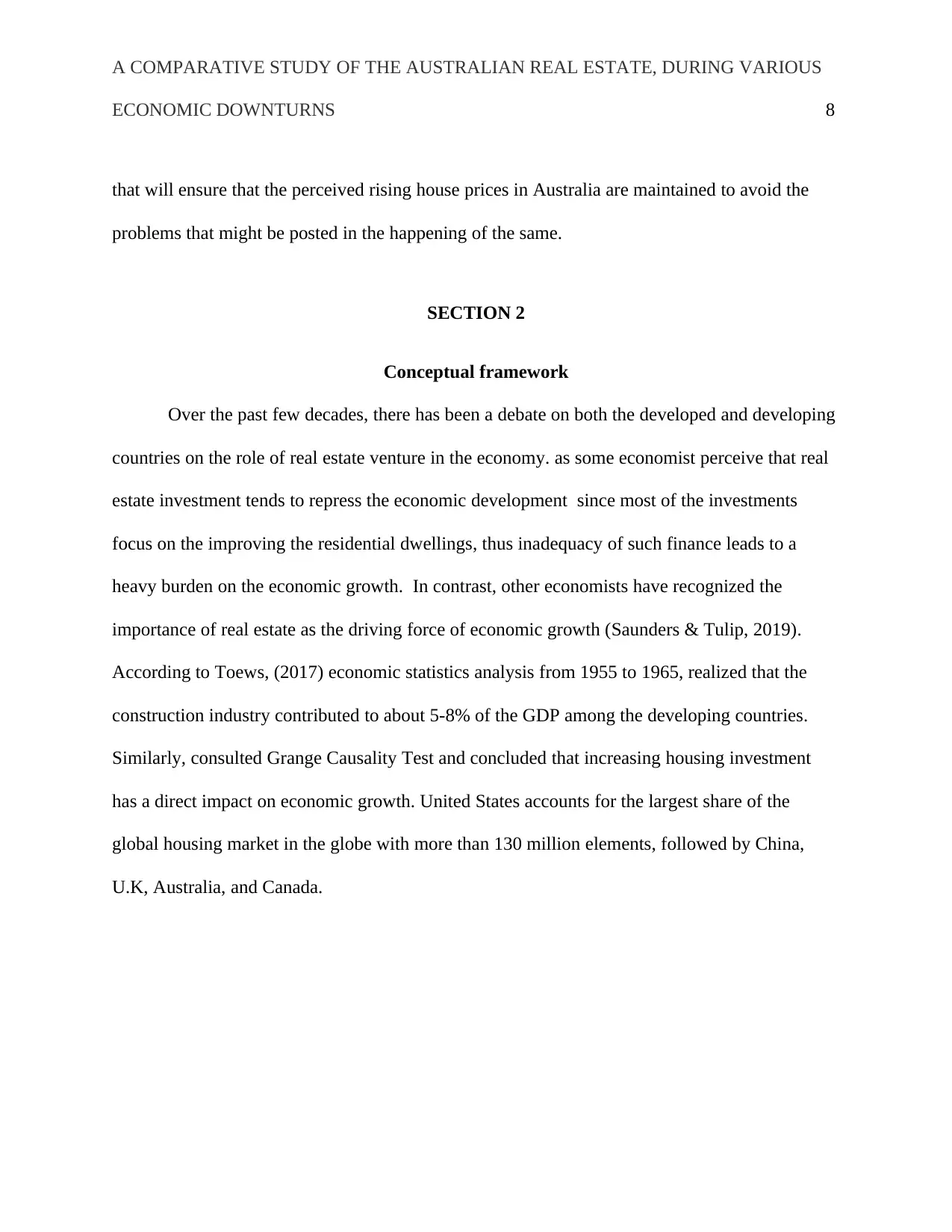
A COMPARATIVE STUDY OF THE AUSTRALIAN REAL ESTATE, DURING VARIOUS
ECONOMIC DOWNTURNS 8
that will ensure that the perceived rising house prices in Australia are maintained to avoid the
problems that might be posted in the happening of the same.
SECTION 2
Conceptual framework
Over the past few decades, there has been a debate on both the developed and developing
countries on the role of real estate venture in the economy. as some economist perceive that real
estate investment tends to repress the economic development since most of the investments
focus on the improving the residential dwellings, thus inadequacy of such finance leads to a
heavy burden on the economic growth. In contrast, other economists have recognized the
importance of real estate as the driving force of economic growth (Saunders & Tulip, 2019).
According to Toews, (2017) economic statistics analysis from 1955 to 1965, realized that the
construction industry contributed to about 5-8% of the GDP among the developing countries.
Similarly, consulted Grange Causality Test and concluded that increasing housing investment
has a direct impact on economic growth. United States accounts for the largest share of the
global housing market in the globe with more than 130 million elements, followed by China,
U.K, Australia, and Canada.
ECONOMIC DOWNTURNS 8
that will ensure that the perceived rising house prices in Australia are maintained to avoid the
problems that might be posted in the happening of the same.
SECTION 2
Conceptual framework
Over the past few decades, there has been a debate on both the developed and developing
countries on the role of real estate venture in the economy. as some economist perceive that real
estate investment tends to repress the economic development since most of the investments
focus on the improving the residential dwellings, thus inadequacy of such finance leads to a
heavy burden on the economic growth. In contrast, other economists have recognized the
importance of real estate as the driving force of economic growth (Saunders & Tulip, 2019).
According to Toews, (2017) economic statistics analysis from 1955 to 1965, realized that the
construction industry contributed to about 5-8% of the GDP among the developing countries.
Similarly, consulted Grange Causality Test and concluded that increasing housing investment
has a direct impact on economic growth. United States accounts for the largest share of the
global housing market in the globe with more than 130 million elements, followed by China,
U.K, Australia, and Canada.
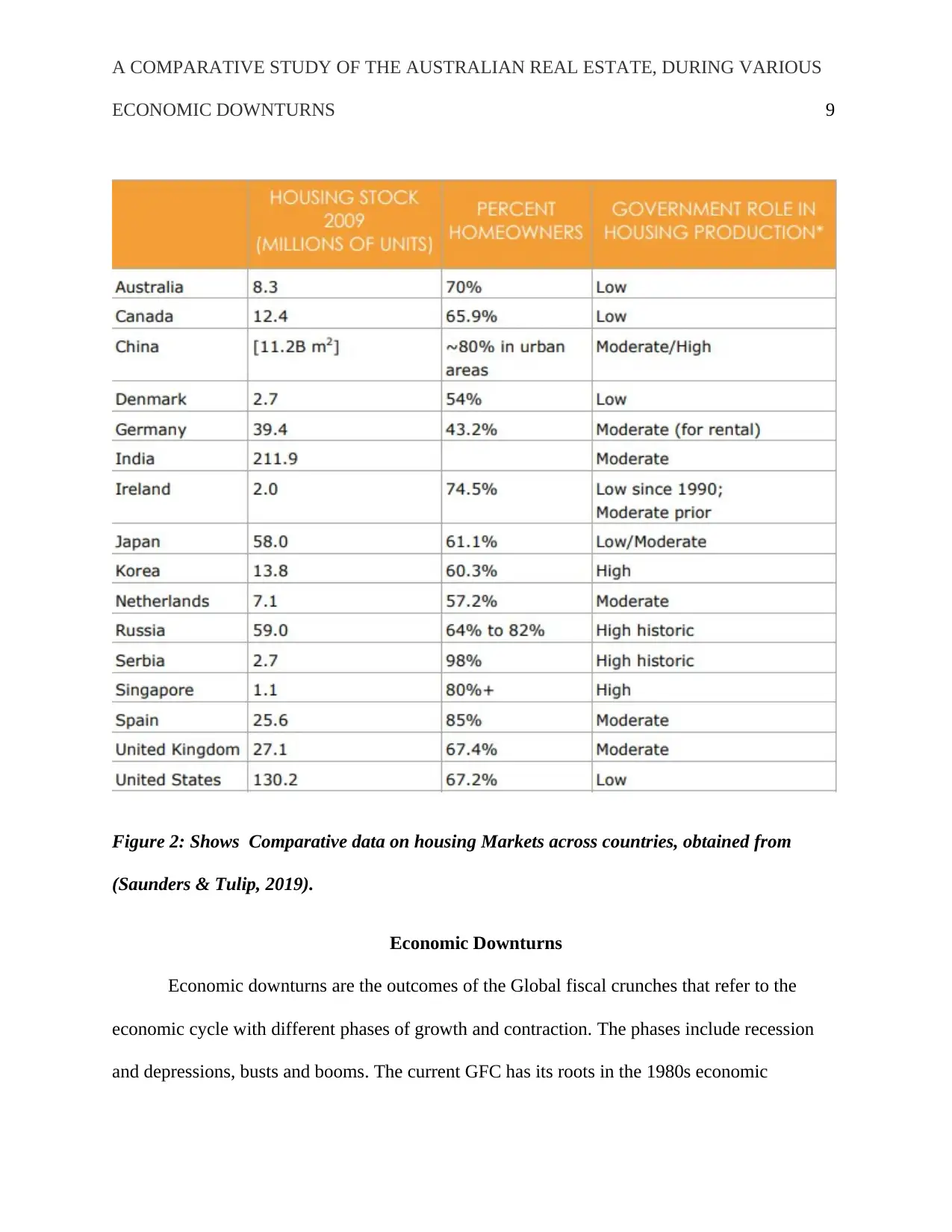
A COMPARATIVE STUDY OF THE AUSTRALIAN REAL ESTATE, DURING VARIOUS
ECONOMIC DOWNTURNS 9
Figure 2: Shows Comparative data on housing Markets across countries, obtained from
(Saunders & Tulip, 2019).
Economic Downturns
Economic downturns are the outcomes of the Global fiscal crunches that refer to the
economic cycle with different phases of growth and contraction. The phases include recession
and depressions, busts and booms. The current GFC has its roots in the 1980s economic
ECONOMIC DOWNTURNS 9
Figure 2: Shows Comparative data on housing Markets across countries, obtained from
(Saunders & Tulip, 2019).
Economic Downturns
Economic downturns are the outcomes of the Global fiscal crunches that refer to the
economic cycle with different phases of growth and contraction. The phases include recession
and depressions, busts and booms. The current GFC has its roots in the 1980s economic
⊘ This is a preview!⊘
Do you want full access?
Subscribe today to unlock all pages.

Trusted by 1+ million students worldwide
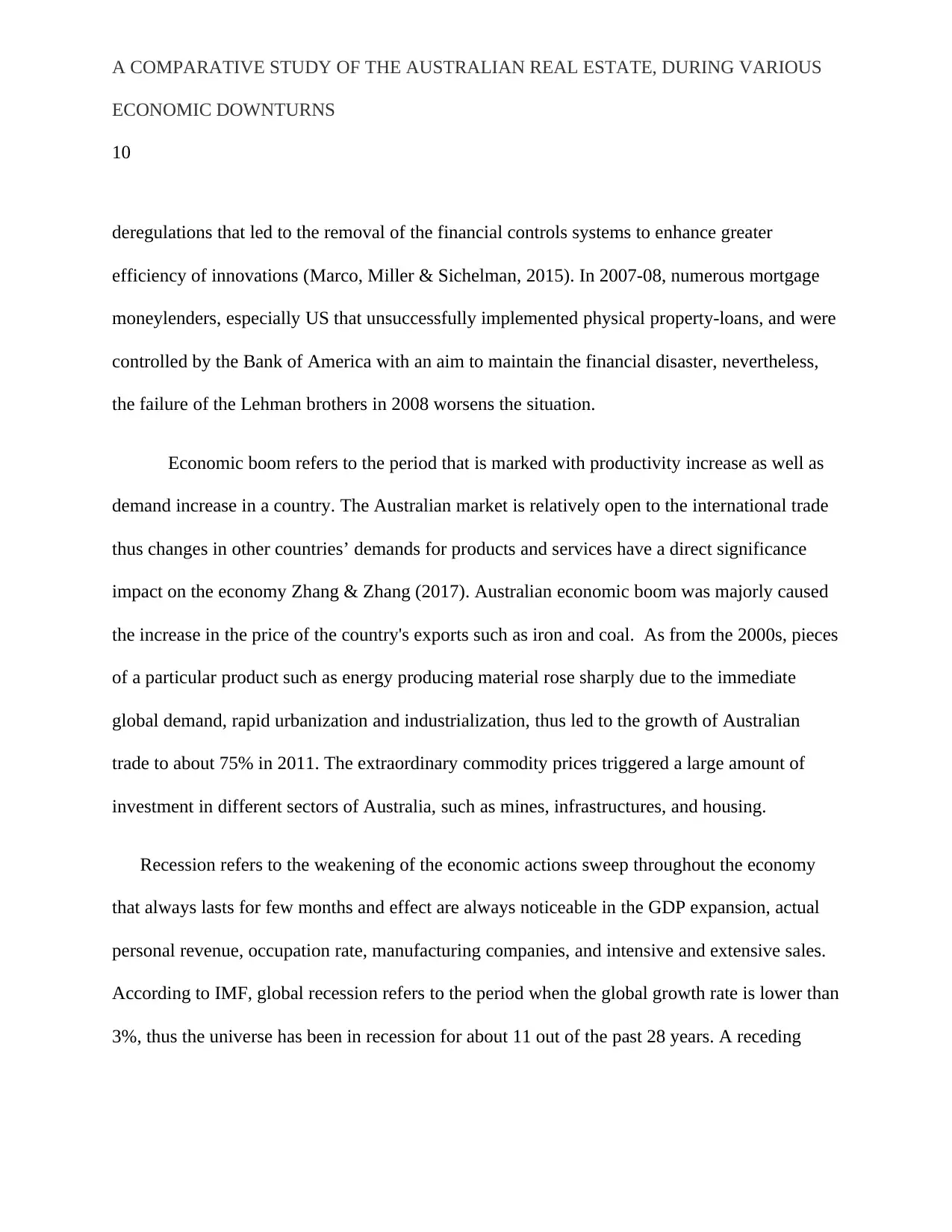
A COMPARATIVE STUDY OF THE AUSTRALIAN REAL ESTATE, DURING VARIOUS
ECONOMIC DOWNTURNS
10
deregulations that led to the removal of the financial controls systems to enhance greater
efficiency of innovations (Marco, Miller & Sichelman, 2015). In 2007-08, numerous mortgage
moneylenders, especially US that unsuccessfully implemented physical property-loans, and were
controlled by the Bank of America with an aim to maintain the financial disaster, nevertheless,
the failure of the Lehman brothers in 2008 worsens the situation.
Economic boom refers to the period that is marked with productivity increase as well as
demand increase in a country. The Australian market is relatively open to the international trade
thus changes in other countries’ demands for products and services have a direct significance
impact on the economy Zhang & Zhang (2017). Australian economic boom was majorly caused
the increase in the price of the country's exports such as iron and coal. As from the 2000s, pieces
of a particular product such as energy producing material rose sharply due to the immediate
global demand, rapid urbanization and industrialization, thus led to the growth of Australian
trade to about 75% in 2011. The extraordinary commodity prices triggered a large amount of
investment in different sectors of Australia, such as mines, infrastructures, and housing.
Recession refers to the weakening of the economic actions sweep throughout the economy
that always lasts for few months and effect are always noticeable in the GDP expansion, actual
personal revenue, occupation rate, manufacturing companies, and intensive and extensive sales.
According to IMF, global recession refers to the period when the global growth rate is lower than
3%, thus the universe has been in recession for about 11 out of the past 28 years. A receding
ECONOMIC DOWNTURNS
10
deregulations that led to the removal of the financial controls systems to enhance greater
efficiency of innovations (Marco, Miller & Sichelman, 2015). In 2007-08, numerous mortgage
moneylenders, especially US that unsuccessfully implemented physical property-loans, and were
controlled by the Bank of America with an aim to maintain the financial disaster, nevertheless,
the failure of the Lehman brothers in 2008 worsens the situation.
Economic boom refers to the period that is marked with productivity increase as well as
demand increase in a country. The Australian market is relatively open to the international trade
thus changes in other countries’ demands for products and services have a direct significance
impact on the economy Zhang & Zhang (2017). Australian economic boom was majorly caused
the increase in the price of the country's exports such as iron and coal. As from the 2000s, pieces
of a particular product such as energy producing material rose sharply due to the immediate
global demand, rapid urbanization and industrialization, thus led to the growth of Australian
trade to about 75% in 2011. The extraordinary commodity prices triggered a large amount of
investment in different sectors of Australia, such as mines, infrastructures, and housing.
Recession refers to the weakening of the economic actions sweep throughout the economy
that always lasts for few months and effect are always noticeable in the GDP expansion, actual
personal revenue, occupation rate, manufacturing companies, and intensive and extensive sales.
According to IMF, global recession refers to the period when the global growth rate is lower than
3%, thus the universe has been in recession for about 11 out of the past 28 years. A receding
Paraphrase This Document
Need a fresh take? Get an instant paraphrase of this document with our AI Paraphraser
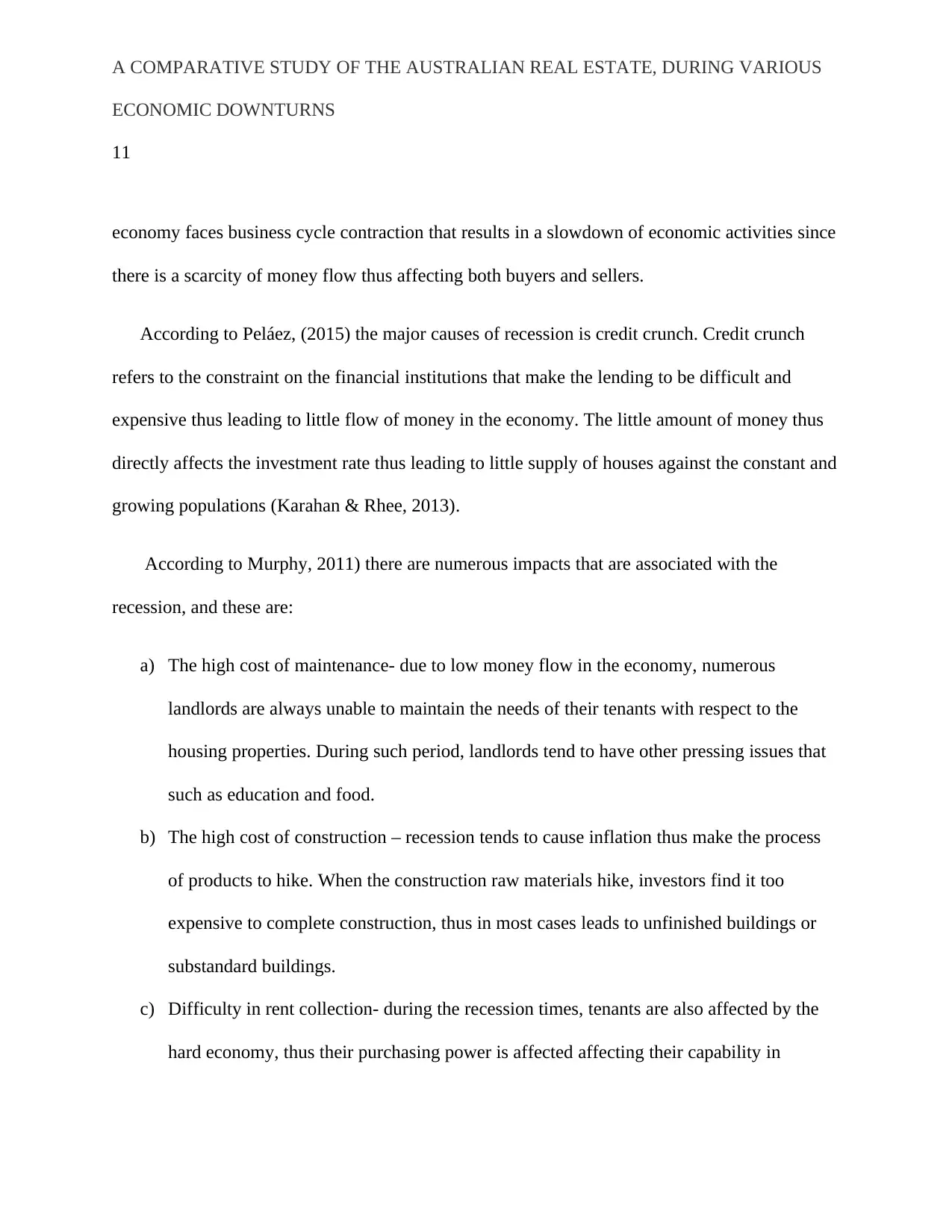
A COMPARATIVE STUDY OF THE AUSTRALIAN REAL ESTATE, DURING VARIOUS
ECONOMIC DOWNTURNS
11
economy faces business cycle contraction that results in a slowdown of economic activities since
there is a scarcity of money flow thus affecting both buyers and sellers.
According to Peláez, (2015) the major causes of recession is credit crunch. Credit crunch
refers to the constraint on the financial institutions that make the lending to be difficult and
expensive thus leading to little flow of money in the economy. The little amount of money thus
directly affects the investment rate thus leading to little supply of houses against the constant and
growing populations (Karahan & Rhee, 2013).
According to Murphy, 2011) there are numerous impacts that are associated with the
recession, and these are:
a) The high cost of maintenance- due to low money flow in the economy, numerous
landlords are always unable to maintain the needs of their tenants with respect to the
housing properties. During such period, landlords tend to have other pressing issues that
such as education and food.
b) The high cost of construction – recession tends to cause inflation thus make the process
of products to hike. When the construction raw materials hike, investors find it too
expensive to complete construction, thus in most cases leads to unfinished buildings or
substandard buildings.
c) Difficulty in rent collection- during the recession times, tenants are also affected by the
hard economy, thus their purchasing power is affected affecting their capability in
ECONOMIC DOWNTURNS
11
economy faces business cycle contraction that results in a slowdown of economic activities since
there is a scarcity of money flow thus affecting both buyers and sellers.
According to Peláez, (2015) the major causes of recession is credit crunch. Credit crunch
refers to the constraint on the financial institutions that make the lending to be difficult and
expensive thus leading to little flow of money in the economy. The little amount of money thus
directly affects the investment rate thus leading to little supply of houses against the constant and
growing populations (Karahan & Rhee, 2013).
According to Murphy, 2011) there are numerous impacts that are associated with the
recession, and these are:
a) The high cost of maintenance- due to low money flow in the economy, numerous
landlords are always unable to maintain the needs of their tenants with respect to the
housing properties. During such period, landlords tend to have other pressing issues that
such as education and food.
b) The high cost of construction – recession tends to cause inflation thus make the process
of products to hike. When the construction raw materials hike, investors find it too
expensive to complete construction, thus in most cases leads to unfinished buildings or
substandard buildings.
c) Difficulty in rent collection- during the recession times, tenants are also affected by the
hard economy, thus their purchasing power is affected affecting their capability in
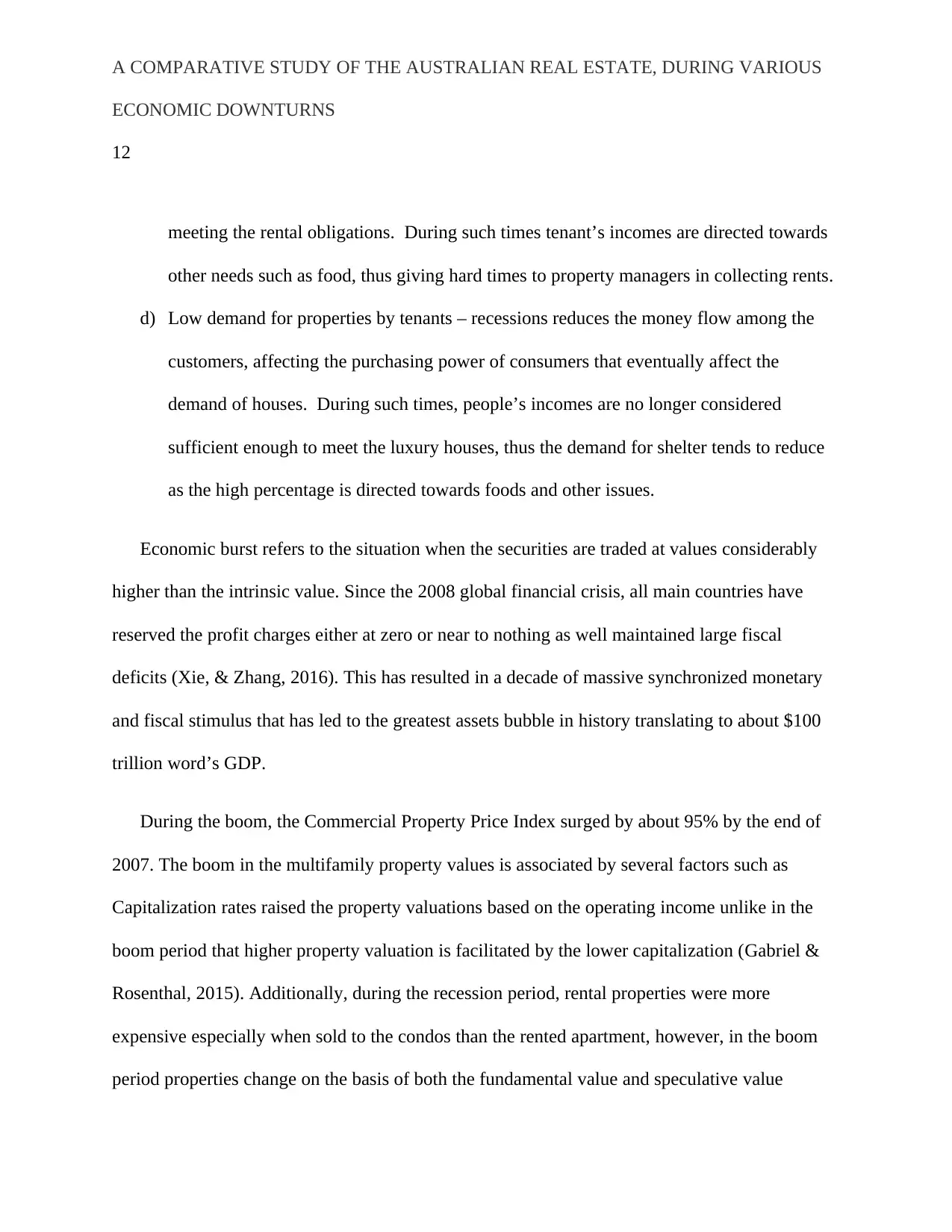
A COMPARATIVE STUDY OF THE AUSTRALIAN REAL ESTATE, DURING VARIOUS
ECONOMIC DOWNTURNS
12
meeting the rental obligations. During such times tenant’s incomes are directed towards
other needs such as food, thus giving hard times to property managers in collecting rents.
d) Low demand for properties by tenants – recessions reduces the money flow among the
customers, affecting the purchasing power of consumers that eventually affect the
demand of houses. During such times, people’s incomes are no longer considered
sufficient enough to meet the luxury houses, thus the demand for shelter tends to reduce
as the high percentage is directed towards foods and other issues.
Economic burst refers to the situation when the securities are traded at values considerably
higher than the intrinsic value. Since the 2008 global financial crisis, all main countries have
reserved the profit charges either at zero or near to nothing as well maintained large fiscal
deficits (Xie, & Zhang, 2016). This has resulted in a decade of massive synchronized monetary
and fiscal stimulus that has led to the greatest assets bubble in history translating to about $100
trillion word’s GDP.
During the boom, the Commercial Property Price Index surged by about 95% by the end of
2007. The boom in the multifamily property values is associated by several factors such as
Capitalization rates raised the property valuations based on the operating income unlike in the
boom period that higher property valuation is facilitated by the lower capitalization (Gabriel &
Rosenthal, 2015). Additionally, during the recession period, rental properties were more
expensive especially when sold to the condos than the rented apartment, however, in the boom
period properties change on the basis of both the fundamental value and speculative value
ECONOMIC DOWNTURNS
12
meeting the rental obligations. During such times tenant’s incomes are directed towards
other needs such as food, thus giving hard times to property managers in collecting rents.
d) Low demand for properties by tenants – recessions reduces the money flow among the
customers, affecting the purchasing power of consumers that eventually affect the
demand of houses. During such times, people’s incomes are no longer considered
sufficient enough to meet the luxury houses, thus the demand for shelter tends to reduce
as the high percentage is directed towards foods and other issues.
Economic burst refers to the situation when the securities are traded at values considerably
higher than the intrinsic value. Since the 2008 global financial crisis, all main countries have
reserved the profit charges either at zero or near to nothing as well maintained large fiscal
deficits (Xie, & Zhang, 2016). This has resulted in a decade of massive synchronized monetary
and fiscal stimulus that has led to the greatest assets bubble in history translating to about $100
trillion word’s GDP.
During the boom, the Commercial Property Price Index surged by about 95% by the end of
2007. The boom in the multifamily property values is associated by several factors such as
Capitalization rates raised the property valuations based on the operating income unlike in the
boom period that higher property valuation is facilitated by the lower capitalization (Gabriel &
Rosenthal, 2015). Additionally, during the recession period, rental properties were more
expensive especially when sold to the condos than the rented apartment, however, in the boom
period properties change on the basis of both the fundamental value and speculative value
⊘ This is a preview!⊘
Do you want full access?
Subscribe today to unlock all pages.

Trusted by 1+ million students worldwide
1 out of 26
Related Documents
Your All-in-One AI-Powered Toolkit for Academic Success.
+13062052269
info@desklib.com
Available 24*7 on WhatsApp / Email
![[object Object]](/_next/static/media/star-bottom.7253800d.svg)
Unlock your academic potential
Copyright © 2020–2025 A2Z Services. All Rights Reserved. Developed and managed by ZUCOL.





